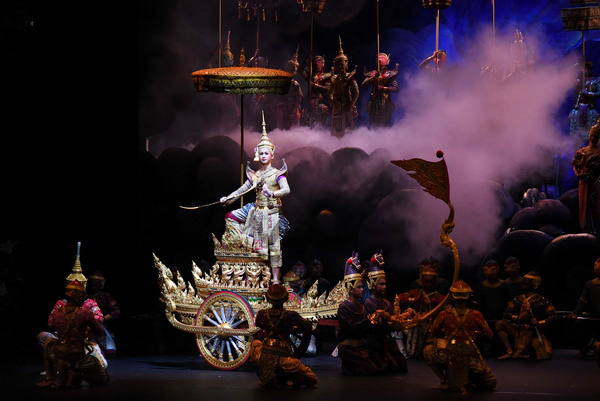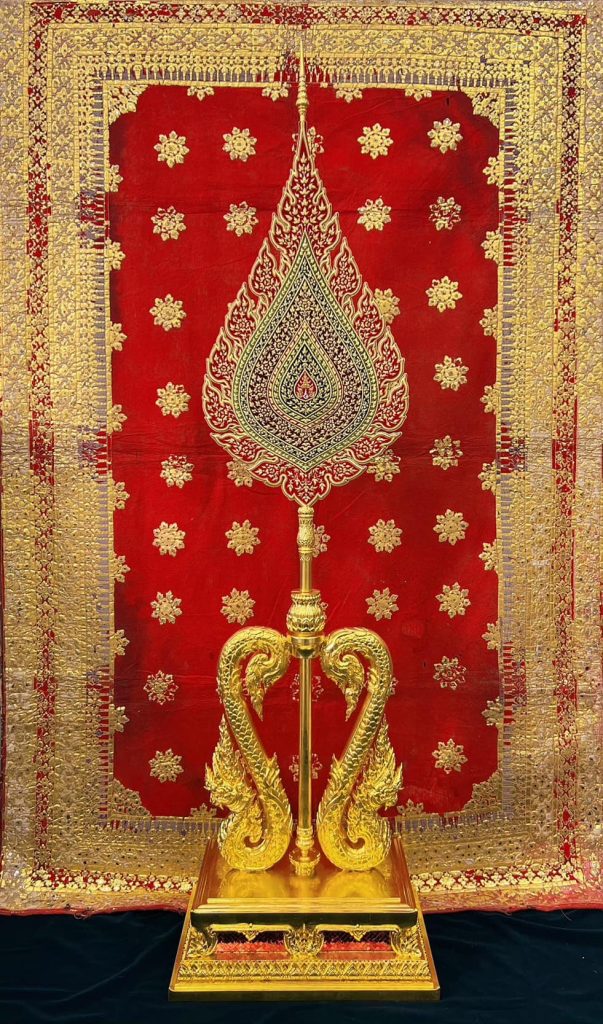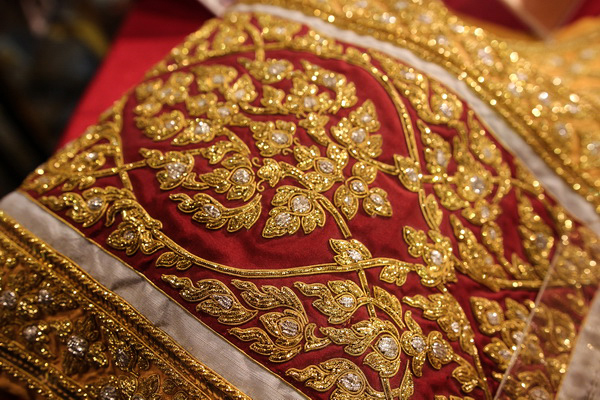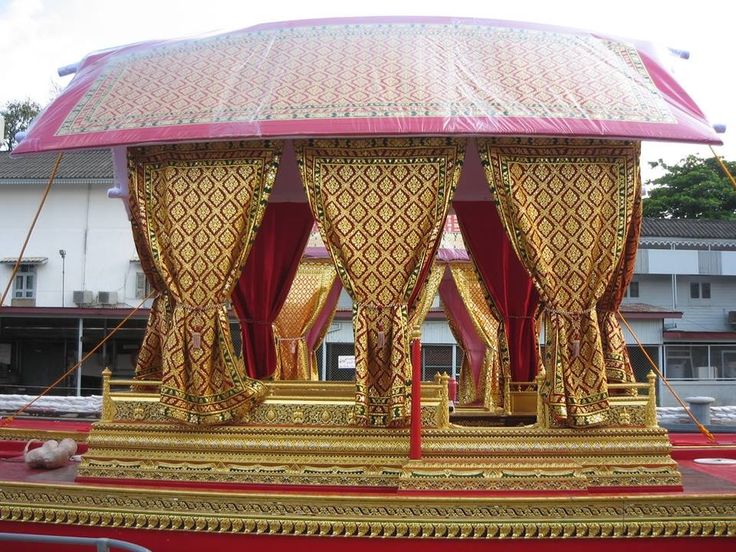Ngan Chang Sana: Thailand’s Ancient Art of Thread and Needles

Thailand is renowned for its rich cultural heritage, including its many forms of exquisite craftsmanship. From intricate wood carvings to stunning ceramics, the country’s traditional arts are sure to captivate those who behold them. Among the treasures of Thai traditional arts lies a lesser-known yet equally enchanting craft: Ngan Chang Sana (งานช่างสนะ).
If you have ever witnessed a traditional Khon dance or visited museums displaying Thai royal regalia, you may have already encountered the artistry of Ngan Chang Sana without realizing it. The elaborate costumes, shimmering ceremonial fans, and intricate decorations are all products of this remarkable craft.
Today, Thailand Foundation invites you to explore the beauty and significance of Ngan Chang Sana, from its history and production techniques to the ongoing efforts to preserve its extraordinary legacy for future generations.

Source: Department of Cultural Promotion
What is Ngan Chang Sana?
Ngan Chang Sana (งานช่างสนะ) refers to a form of traditional Thai craftsmanship rooted in the meticulous art of creating, repairing, and embellishing fabric, leather, and paper items. The craft involves intricate techniques such as stitching, embroidery, appliqué, and weaving to produce exquisite works of art. The creations range from ceremonial items, such as monks’ fans and royal fans, to traditional theater costumes, such as Khon and Lakhon outfits.
More than just creating new pieces, Ngan Chang Sana also encompasses the restoration and maintenance of older artifacts, preserving their beauty and historical significance. The craft requires a deep understanding of materials, colors, and techniques to create patterns using silk threads, sequins, metallic threads, and other decorative elements.
Producing Ngan Chang Sana
The production process of Ngan Chang Sana is an intricate art that involves various traditional techniques to create decorative and functional works. These techniques can be grouped into two major components: cutting and sewing and embellishment.
Cutting and Sewing
The foundation of Ngan Chang Sana begins with cutting fabrics and other base materials into precise shapes and sewing them into structured forms. These may include military uniforms, ceremonial garments, and headpieces. Once the base is prepared, artisans proceed with the embellishment process.
Embellishment
Embellishment is the process of creating decorative patterns on the base material. This process involves the use of several techniques, depending on artistic preference or purpose of the created piece. These include:
- Embroidery (ปัก) – the process of sewing silk threads, metallic threads, beads, and sequins onto fabric to create decorative patterns.
- Dense Embroidery (ปักทึบ) – tightly stitching materials like silk threads onto fabric to form detailed designs, often for smaller areas. Padding is added first if a raised texture is desired.
- Layered Embroidery (ปักซอย) – similar to dense embroidery but is used for larger patterns. It ensures the entire design is filled evenly, offering a cleaner finish for bigger designs.
- Sequin Embroidery (ปักเลื่อม) – involves attaching round silver or gold sequins to fabric, adding sparkle and intricate detail to the design.
- Metallic Wire Embroidery (ปักดิ้นข้อ ดิ้นมัน และดิ้นด้าน) – uses thin, flexible gold and silver wires cut into short pieces and sewn onto fabric. The threads are secured with stitches along the design to keep them in place.
- Hollow Metallic Thread Embroidery (ปักดิ้นโปร่ง) – features square-shaped, hollow, and flexible threads in gold and silver. These threads are stitched over fabric with slight overlaps and supported by underlying threads to secure the design.
- Metal Strip Embroidery (ปักดิ้นแล่ง) – uses thin, flat strips of gold or silver metal sewn into designs, giving a shiny, elegant appearance. The type of metal strip is chosen based on the project.
- Crossed Gold Thread Embroidery (ปักหักทองขวาง) – involves stretching gold threads across a design in a crisscross pattern without sewing them through the fabric, commonly seen in royal decorations like ceremonial umbrellas.
- Mesh Weaving (ถักกรองทอง) – the technique of weaving gold or silver threads into a fine, net-like fabric, which is then decorated with embroidery, often used in royal garments.
- Gold-Laminated Textiles (ผ้าลายทองแผ่ลวด) – made by teams of skilled artisans who design patterns, emboss them, cover them with gold leaf, and add glass decorations. The final piece is stitched onto fabric with thick threads along the design and thin threads to hold the details securely, used for royal curtains, boat canopies, and other ceremonial items.

Source: Office of Traditional Arts, Fine Arts Department
History of the Craft
Ayutthaya Period
The origins of Ngan Chang Sana can be traced back to the Ayutthaya period (1351-1767), where it was recognized as a specialized craft in royal service. The Three Seals Law (กฎหมายตราสามดวง), a legal document from that era, lists its craftsmen as part of the Department of Textiles (กรมพระภูษา), with both Thai and Chinese artisans contributing to its development. Highly esteemed for their expertise, these artisans created and restored intricate textiles, leather goods, and ceremonial items. They played a crucial role in producing costumes for traditional performances, royal ceremonies, and religious rituals. The law also outlined their many ranks and responsibilities, underscoring their significance to the royal court.
Rattanakosin Period
The craft flourished during the early Rattanakosin period under King Rama I (1782-1809), who reorganized artisan groups into a formal structure known as the Ten Divisions of Craftsmen (กรมช่างสิบหมู่). Ngan Chang Sana became a part of this structure. Artisans were tasked with crafting items for significant events, including military uniforms, ceremonial fans, and Khon masks.
During King Rama IV’s reign (1851-1868), administrative reforms further refined the organization of Ngan Chang Sana within the civil service. By King Rama V’s reign (1868-1910), modernization efforts led to the restructuring of these traditional crafts. Artisans were integrated into civilian departments, separating them from the military hierarchy they were once tied to.
Challenges in the 20th Century
The early 20th century presented challenges for Ngan Chang Sana as socio-economic changes and global conflicts, such as World War I, led to shifts in priorities and funding. Many artisan divisions were merged or dissolved, and their functions were absorbed into broader departments, such as the Fine Arts Department. Despite these challenges, efforts to preserve Ngan Chang Sana continued through royal patronage and institutional support.
Modern Preservation Efforts
In recent decades, organizations like the Queen Sirikit Institute and the Fine Arts Department have taken significant steps to revive and sustain Ngan Chang Sana. The Queen Sirikit Institute trains artisans from rural and underprivileged backgrounds, providing them with opportunities to hone their skills in traditional crafts. Similarly, institutions like the Royal Traditional Thai Crafts School offer specialized training in Ngan Chang Sana techniques, ensuring that these intricate skills are passed on to future generations.
Today, Ngan Chang Sana is recognized as a cherished component of Thailand’s cultural heritage. The Department of Cultural Promotion has inscribed it on the National Intangible Cultural Heritage list. While modern lifestyle and technology have influenced its practices, the craft remains a symbol of the nation’s artistic ingenuity and historical identity. The preservation of Ngan Chang Sana highlights the importance of traditional arts in maintaining a connection to Thailand’s rich cultural past.

Source: Department of Cultural Promotion
The Values of Ngan Chang Sana
Ngan Chang Sana reflects Thailand’s artistic heritage through its elegance, refinement, and attention to detail. This traditional craft embodies the cultural values and creative spirit that have shaped Thai artistry for centuries.
At its heart, Ngan Chang Sana highlights the skill of Thai artisans. The precise embroidery, intricate gold-thread patterns, and careful construction demonstrate mastery of materials and techniques passed down through generations. Artisans transform silk threads, metallic foils, and sequins into stunning works, seen in Khon costumes, ceremonial fans, and royal regalia – each unique piece a testament to Thailand’s craftsmanship.
The meticulous attention to detail in Ngan Chang Sana sets it apart. Every stitch and embellishment is deliberately placed, seamlessly combining complex techniques like gold-thread weaving and metal strip embroidery into cohesive designs. This craft’s elegance is evident in everything from royal garments to ceremonial curtains, where balanced colors, textures, and patterns showcase a deep understanding of aesthetics.
More than technical expertise, Ngan Chang Sana preserves the essence of Thai culture: the attention to detail and refinement. It bridges past and present, maintaining the grace of traditional craftsmanship while inspiring contemporary interpretations. Honoring this art form reinforces Thailand’s cultural identity and ensures that its legacy endures for future generations.

Source: Pinterest/NitRudy
Conclusion
Ngan Chang Sana stands as a remarkable testament to Thailand’s rich artistic heritage and craftsmanship. As this traditional craft faces the challenges of modern times, efforts to preserve and celebrate it become even more vital. If you ever have the chance to visit Thailand, take the opportunity to explore the world of Ngan Chang Sana. Whether through exhibitions, cultural performances, or visits to institutions dedicated to preserving traditional arts, witnessing this exquisite craft up close offers a deeper appreciation of Thailand’s artistry and creativity.
Ngan Chang Sana is a classical aspect of Thai culture and heritage. The craft reflects the artistic mastery and attention to detail of the Thai people. Join us in exploring more stories of Thailand and the Thai people as we take you on a journey to discover Thainess.
Sources:
- Department of Cultural Promotion
*This article is written with the help of AI.
Written by: Tayud Mongkolrat


